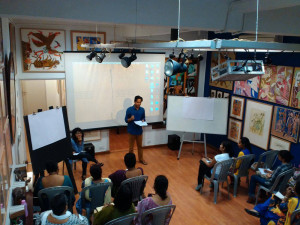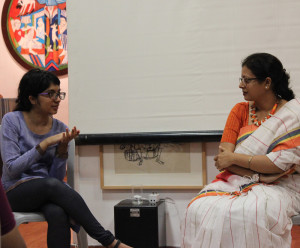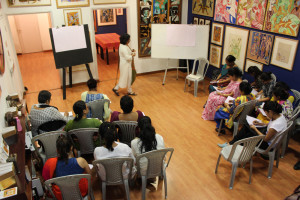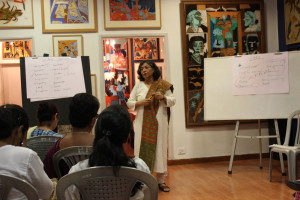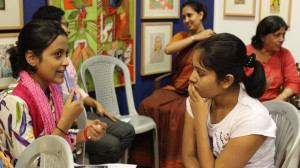‘Since I have to go to my village to sell my land along with my wife, please sanction me one-week leave.’
A joke. Perhaps circulated on social media.
‘Lolz’
The reply to the joke.
Language is a complicated topic. Not the study of language, but the use and the baggage that come with the use. In particular, linguistic elitism. Joyeeta Dey, researcher with the History for Peace project and Tanmay Dhanania, actor, started off the workshop on ‘Recognising Bias’ on 15 July 2016, with a session on linguistic elitism, with emphasis on schools using a mix of performance, media, sharing and discussion.
Tanmay started the session with a narration of The Professor, a poem by Nissim Ezekiel, following it with a poem by Daljit Nagra, an extract from Arundhati Roy’s God of Small Things, excerpts from Dalit literature and an excerpt from Trainspotting by Irvine Welsh. Interspersed and inspired by these performances were discussions led by Joyeeta and Tanmay about the use of English and the status that it occupies in our daily lives. How speaking in English has almost become a status symbol, and how while being a language of liberation, it has simultaneously sidelined communities, led to exclusion in schools and become a source of bias, in classrooms and in society at large.
Joyeeta showed the participants a photograph of ‘Angrezi Devi’ a Dalit Goddess of an English temple, highlighting the interesting position that the language occupies—a position of reverence in a community that has traditionally been repressed. A slide showing Aatish Taseer’s opinion on Indian writing in English and the comparison of an Arundhati Roy and a Chetan Bhagat lead to an interesting discussion on reading habits in the country, and what is considered ‘good literature’. The video Stephen Fry’s Kinetic Typology- Language on the ‘proper’ use of language led to some participants commenting on the use of English as a tool for communication, without emphasis on the proper use of the language. After all, what is ‘proper’ in this case? As Tanmay mentioned, is it the pronunciation? Joyeeta ended her presentation by giving participants an idea of the scenario with respect to language in the Indian educational system.
After a quick break for refreshments, we resumed with a conversation between Joyeeta and Ms Lopamudra Mukherjee, a teacher of Bengali at Ballygunge Shiksha Sadan. From being someone who thought that the Bengali language was simply not important enough, to going on to study the language at University and becoming a teacher of the subject, Ms Mukherjee spoke about how the decision to study Bengali was not an easy one. But a decision that nevertheless changed her life. She shared instances where students are unable to communicate entirely in Bengali, often interspersing words in English. The general disinterest in the subject is not just amongst the students, but also amongst the parents, who view the subject as one in which ‘pass marks’ are adequate. Often there is a sense of pride when the child is not fluent, or unable to converse at all in Bengali because it means that, he or she is better at English. Although every student speaks English fluently, it is not always correct English. Grammatical errors creep in more often than not.
Joyeeta and Tanmay set the context for the workshop by highlighting biases, with respect to linguistic bias. Gulan Kripalani, Transformational Leadership Development facilitator and Development Communications professional, took it forward by working extensively with the participants, to help them recognise and address their own biases.
She began her session by talking about ‘change’. She provided a very realistic picture when she said that to bring about change is very difficult ‘out there’. The only change we can take full control of is the change ‘in here’ i.e., change within us. She then raised a topic about identity, calling it multifarious. We have multiple identities that exist simultaneously – social, professional, psychological, etc. Moreover, there is no ‘right’ or ‘wrong’ to these identities as they are completely subjective. Among so many differences and so many identities, one thing that binds us together is humanity—the glue that can make change possible in society.
The first activity underlined identity where everyone present in the room had to introduce themselves and talk about 3 things, (a) what their contribution to life would be (b) where they see themselves professionally in five years (c) three unique qualities that defined them. Each individual was allowed to share with other, the responses to these questions. Many of the participants hesitated while voicing out their unique qualities showing the lack of self-identification. Unless an individual does not recognise the goodness in himself/herself, it becomes difficult to see the same in others. This is the very first step of change, self-identification or knowing your ubuntu (qualities of a person), which Gulan showed us through this simple activity.
Another exercise followed where the audience was asked to list the qualities of his or her ideal person. Soon after, they were asked to cite their fears. Strangely, the qualities and fears seemed as though they were pair of antonyms. We all want to acquire the qualities we see in our ideal person but there is the background voice of fear that holds us back and lures us to gain certain biases. One of the remedies by which we can conquer this fear, as Gulan pointed out is by noticing it. Only by naming the fear can we shield ourselves from acquiring those unnamed biases and prejudices.
‘Listening is a rare happening among human beings …’ William Stringfellow, on Listening.
The final exercise was based entirely on that premise. Participants were paired up, with one speaking about what they are proud of—their achievements, and the other instructed to completely ignore what their partner was saying. After this exercise, participants shared their feelings of frustration and anguish when their partner did not pay any heed to them. These feelings were born out of a brief exercise, which as Gulan highlighted, would be so many more times amplified for individuals whose voices have not been heard or ignored, for years. Similarly, bringing the analogy into the classroom, it is perhaps an experience students go through when their teachers refuse to listen to them, either because of biases or a lack of time and patience.
We are often too quick to categorize children and even adults, based on the voices in our head. In a typical class there are the troublemakers, the backbenchers and the ones who always finish their homework. It is all too easy to give the voices in our heads and therefore our biases, precedence when it comes to interacting with these students.
Gulan emphasized the fact that it is a huge challenge to ignore and ultimately get rid of these background voices or biases. The first step to meeting that challenge is to acknowledge the voices, and know when they are moving from the background to the front, and keep them in check. In the classroom, or elsewhere, it is vitally important to not give ones own biases the upper hand.
– Shreyashee Roy
Intern

